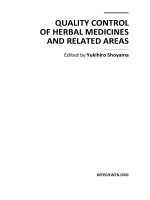Quality Control of Garment
Bạn đang xem bản rút gọn của tài liệu. Xem và tải ngay bản đầy đủ của tài liệu tại đây (782.09 KB, 52 trang )
Quality Control Of Garment
QUALITY SYSTEMS FOR
QUALITY SYSTEMS FOR
GARMENT
GARMENT
MANUFACTURE
MANUFACTURE
ACHIEVING THE RIGHT FINAL PRODUCT ON TIME
1.
1.
PLAN OF THE OVERALL FUNCTION OF QUALITY
PLAN OF THE OVERALL FUNCTION OF QUALITY
CONTROL
CONTROL
•
The cost of quality
•
Functions of Quality Assurance
•
Commercial advantages form effective control systems
•
Economic aspects of quality assurance
•
The role of quality control
2. THE ROLE OF QUALITY CONTROL IN
THE CONTEXT OF QUALITY
MANAGEMENT
•
Outline of quality control systems requirements
•
Data generated
•
British Standard 5750
3.
FINAL PRODUCT SPECIFICATIONS
FINAL PRODUCT SPECIFICATIONS
•
Quality control in the sampling/development department
•
From sample to full production
•
The Specification layout
•
Process specification
•
Sample garment specification
•
Seam specification
•
Performance specification
4.
THE MAIN RAW MATERIAL - FABRIC
THE MAIN RAW MATERIAL - FABRIC
•
Fabric and garment dimensions - fabric stability and
finished width
•
Fabric inspection - examination of fabric on receipt
5.
BASIC SEAMING TECHNOLOGY
BASIC SEAMING TECHNOLOGY
•
Basic technology of seams
•
Stitch forming action
•
Quality checks on seams
6.
LAYING-UP AND CUTTING
LAYING-UP AND CUTTING
6.
QUALITY MONITORING THROUGH
QUALITY MONITORING THROUGH
CUTTING AND GARMENT ASSEMBLY
CUTTING AND GARMENT ASSEMBLY
7.1
Recording
Recording
•
Recording systems - making up
•
Supervisors check list
7.2
Tolerances
Tolerances
•
Tolerance limits
7.3
The threshold of faults
The threshold of faults
•
Training quality standards and faults analysis
7.4
Sampling techniques
Sampling techniques
•
Checking levels of faults and seconds
7.5
Technology if Inspection
Technology if Inspection
•
Garment examination
•
Seeing colour and the effect of type of illuminant on the
apparent shade of a sample
•
Effects of intensity, angle of illumination and type on the
apparent shade of a sample
•
Effects on shade of other colours in adjacent areas
•
Mounting and displaying for viewing
•
Colour vision
7.6
checking operatives and examiners
checking operatives and examiners
•
Assessment of operative effectiveness from records
•
The supervisor and quality control
•
Weather trials
7.7
Auditing Boxed Stock
Auditing Boxed Stock
•
Boxed Stock Quality Audit
8.
QUALITY COMMUNICATIONS
QUALITY COMMUNICATIONS
•
Control of quality in garment assembly
•
Example of quality feedback - marks and stains
•
Action checklist to improve garment cleanliness
•
economics of cleanliness
•
Fault cost assessment record
•
Quality Control Requirements - Order of Priorities
"
"
Quality"
Quality"
is defined as that combination of
design and properties of materials of a
product which are needed for the intended
end use and level of the market in which it is
sold.
"Requisite Quality"
"Requisite Quality"
is defined as the
design and composition of a product, which
has been thoroughly proved by adequate
development work, in order to establish its
reliability under the conditions to which it will
be subjected in use and to avoid producing
too high a grade of product for the intended
market.
Quality Assurance
Quality Assurance
"The establishment and maintenance of ALL
activities and functions concerned with the
attainment of requisite quality"
Quality Control
Quality Control
"The systems required for programming and
co-ordinating the efforts of the various
groups in an organisation to maintain the
requisite quality" As such Quality Control is
seen as the agent of Quality Assurance or
Total Quality Control
Quality for textile and apparel:
Quality for textile and apparel:
Quality may be defined as the level of
acceptance of goods or services.
For the textile and apparel industry, product
quality is calculated in terms of quality and
standard of fibers, yarns, fabric construction,
colour fastness, designs and the final finished
garments. Quality control in terms of garment
manufacturing, pre-sales and posts
sales service, delivery, pricing, etc are essential
for any garment manufacturer, trader or exporter.
Certain quality related problems, often seen in
garment manufacturing like sewing, colour,
sizing, or garment defects should never be over
looked.
These defects are discussed below -
Sewing defects
Sewing defects
Open seams, wrong stitching techniques, non-
matching threads, missing stitches, improper
creasing of the garment, improper thread
tension etc. are some of the sewing defects
which can affect the garment quality adversely.
Colour defects
Colour defects
Variation of colour between the sample and the
final garment, wrong colour combinations and
mismatching dyes should always be avoided.
Sizing defects
Sizing defects
Wrong gradation of sizes, difference in
measurement of various parts of a garment like
sleeves of XL size for body of L size garment
can deteriorate the garments beyond repair.
Garment defects
Garment defects
Broken or defective buttons, snaps, stitches,
different shades within the same garment,
dropped stitches, exposed notches, fabric
defects, holes, faulty zippers, loose or hanging
sewing threads, misaligned buttons and holes,
missing buttons, needle cuts, pulled or loose
yarn,
stains, unfinished buttonhole, short zippers,
inappropriate trimmings etc. all can lead to the
end of a brand name even before its
establishment.
Some of main fabric properties that are
taken into consideration for garment
manufacturing for export basis:
• Overall look of the garment.
• Right formation of the garment.
• Feel and fall of the garment.
• Physical properties.
• Colour fastness of the garment.
• Finishing properties
• Presentation of the final produced garment.
Methods of quality control:
Methods of quality control:
Basically two methods are used for garments
quality control –
i) Testing
ii) Inspection.
Maximum garments manufacturers apply
inspection method due to high cost of testing
equipments.









